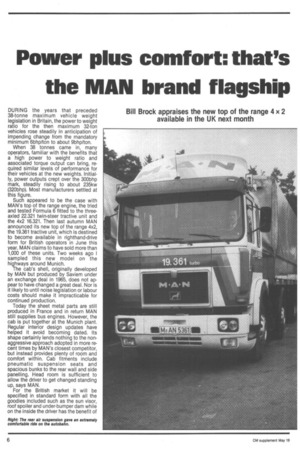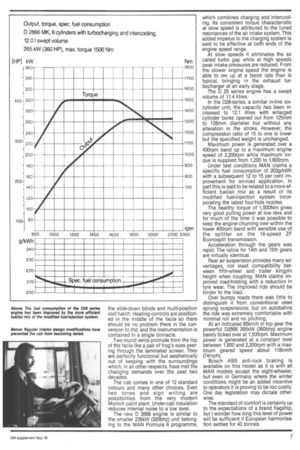Power plus comfort: that's the MAN brand flagship
Page 58

Page 59

If you've noticed an error in this article please click here to report it so we can fix it.
Bill Brock appraises the new top of the range 4 x 2 available in the UK next month
DURING the years that preceded 38-tonne maximum vehicle weight legislation in Britain, the power to weight ratio for the then maximum 32-ton vehicles rose steadily in anticipation of impending change from the mandatory minimum 6bhpiton to about 9bhpiton.
When 38 tonnes came in, many operators, familiar with the benefits that a high power to weight ratio and associated torque output can bring, required similar levels of performance for their vehicles at the new weights. Initially, power outputs crept over the 300bhp mark, steadily rising to about 235kw (320bhp). Most manufacturers settled at this figure.
Such appeared to be the case with MAN's top of the range engine, the tried and tested Formula 6 fitted to the threeaxled 22.321 twin-steer tractive unit and the 4x2 16.321. Then last autumn MAN announced its new top of the range 4x2, the 19.361 tractive unit, which is destined to become available in righthand-drive form for British operators in June this year. MAN claims to have sold more than 1,000 of these units. Two weeks ago I sampled this new model on the highways around Munich.
The cab's shell, originally developed by MAN but produced by Saviem under an exchange deal in 1965, does not appear to have changed a great deal. Nor is it likely to until noise legislation or labour costs should make it impracticable for continued production.
Today the sheet metal parts are still produced in France and in return MAN still supplies bus engines. However, the cab is put together at the Munich plant. Regular interior design updates have helped it avoid becoming dated. Its shape certainly lends nothing to the nonaggressive approach adopted in more recent times by MAN's closest competitor, but instead provides plenty of room and comfort within. Cab fitments include pneumatic suspension seats and spacious bunks to the rear wall and side panelling. Head room is sufficient to allow the driver to get changed standing up, says MAN.
For the British market it will be specified in standard form with all the goodies included such as the sun visor, roof spoiler and under-bumper dam while on the inside the driver has the benefit of the slide-down blinds and multi-position roof hatch. Heating controls are positioned in the middle of the facia so there should be no problem there in the conversion to rhd, and the instrumentation is contained in a single binnacle.
Two round vents protrude from the top of the facia like a pair of frog's eyes peering through the laminated screen. They are perfectly functional but aesthetically out of keeping with the surroundings which, in all other respects, have met the changing demands over the past two decades.
The cab comes in one of 12 standard colours and many other choices. Even two tones and sign writing are possibilities from the very modern Munich paint plant. Under-cab insulation reduces internal noise to a low level.
The new D 2866 engine is similar to the smaller 235kW (320bhp) unit belonging to the MAN Formula 6 programme, which combines charging and intercooling. Its consistent torque characteristic at slow speed is attributed to the tuned resonances of the air intake system. This added impetus to the charging system is said to be effective at both ends of the engine speed range.
At slow speeds it eliminates the so called turbo gap while at high speeds peak intake pressures are reduced. From the slower engine speed the engine is able to rev up at a faster rate than is typical, bringing in the exhaust turbocharger at an early stage.
The D 25 series engine has a swept volume of 11.4 litres.
In the D28-series, a similar in-line sixcylinder unit, the capacity has been increased to 12.1 litres with enlarged cylinder bores opened out from 125mm to 128mm diameter but without any alteration in the stroke. However, the compression ratio of 15 to one is lower but the specified weight is unchanged.
Maximum power is generated over a 400rpm band up to a maximum engine speed of 2,200rpm while maximum torque is supplied from 1,200 to 1,600rpm.
Under test conditions MAN claims a specific fuel consumption of 203g/kWh with a subsequent 12 to 15 per cent improvement for on-road application. In part this is said to be related to a more efficient fuel/air mix as a result of its modified fuel-injection system incorporating the latest four-hole nozzles.
The healthy torque of 1,500Nm gives very good pulling power at low revs and for much of the time it was possible to keep the engine churning over within the lower 400rpm band with sensible use of the splitter on the 16-speed ZF Econosplit transmission.
Acceleration through the gears was rapid. The ratios for 14th and 15th gears are virtually identical.
Rear air suspension provides many advantages, not least compatibility between fifth-wheel and trailer kingpin height when coupling. MAN claims improved road-holding with a reduction in tyre wear. The improved ride should be kinder to the load.
Over bumpy roads there was little to distinguish it from conventional steel sprung suspensions, but on autobahns the ride was extremely comfortable with minimal roll and no pitching.
At an indicated 85km/h in top gear the powerful D2866 265kW (360bhp) engine barely ticked over at 1,500rpm. Maximum power is generated at a constant level between 1,800 and 2,200rpm with a maximum geared speed about 118km/h (74mph).
Bosch ABS anti-lock braking is available on this model as it is with all MAN models except the eight-wheeler, but even in Germany where the winter conditions might be an added incentive to operators it is proving to be too costly. One day legislation may dictate otherwise.
The standard of comfort is certainly up to the expectations of a brand flagship, but I wonder how long this level of power will be sufficient if European harmonisation settles for 40 tonnes.
























































































































